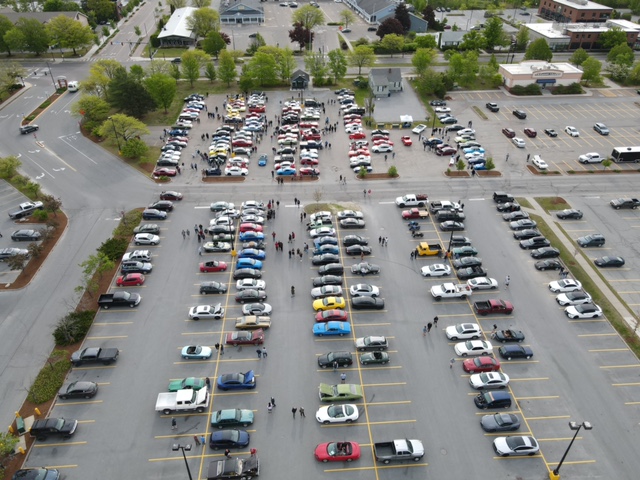Pics from the May Cars and Coffee gathering at the University all in Burlington, Vermont.
Wheel Tracks Articles Archives
1914 Cadillac Touring Car
This 1914 Cadillac Touring car began its life in Iowa Park, Texas when Ernst Goetze needed transportation.
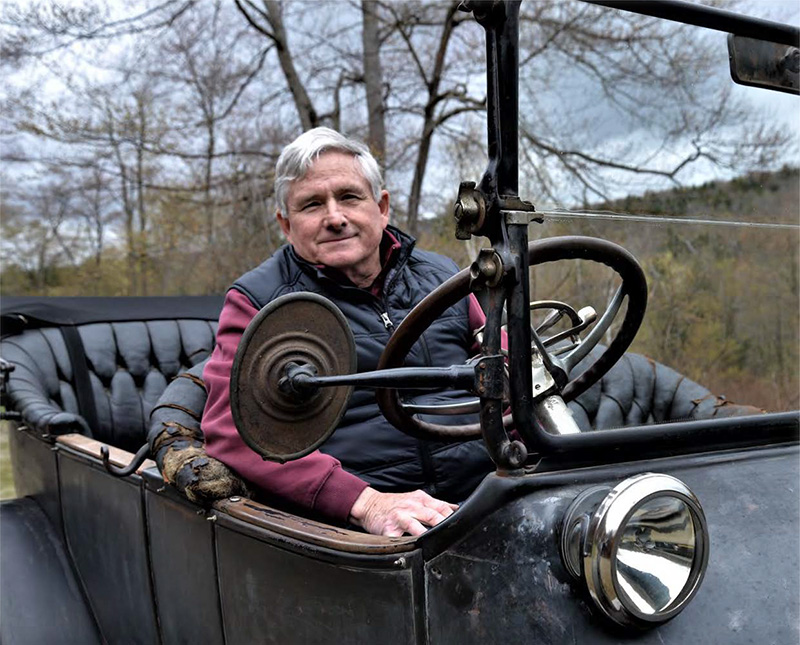
Today, it is garaged in Ludlow, Vermont. Brian Wood is now the Cadillac’s owner/caretaker.
Mr. Goetze, an immigrant from Saxony, Germany, was a cattleman in Iowa Park, Texas. He had seen the two neighbor girls with broken arms and decided that any car he bought must have electric starting and electric lights.
He turned down Chevys, Fords and Oldsmobiles until June 5, 1914 when Mr. Claspy from the Munger Motor Company in Wichita Falls showed him this Brewster green Cadillac. After a trial ride, Mr. Goetze bought the car and presented it to his two daughters, Lina and Frieda, on condition that they care for it and drive him wherever he wished to go. He had lost the use of his left arm in an accident with a horse and could not drive himself.
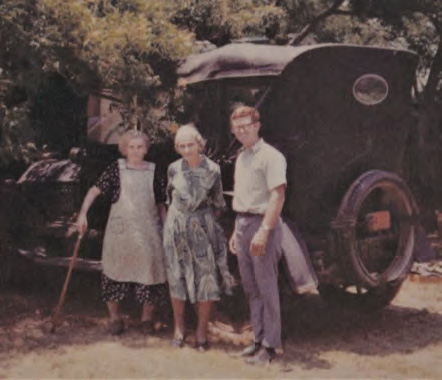
With the car came the Dykes Visual Aids book, a creeper, trouble light, snow chains, tools and such accessories as the spring-loaded bumper and spare tire. It also had white tires. A garage was built for the Cadillac, and it was put inside on jacks after each outing. Miss Lina and Miss Frieda remember that usually Mr. Goetze would ask if they had set the jacks back under the car and admitted that sometimes they fibbed.
Miss Lina told of returning from town and outrunning a rainstorm. “I stepped on it and we were really flying. My father was in the rear and, as I glanced back, I saw he was holding the rail in both hands. We flew all the way home and just as we rolled into the garage, the biggest rain you ever did see burst out. I knew he didn’t like my speeding, but Father never said a word.”
Around 1920, the Cadillac passed her 100,000 mile mark and the Goetzes joined the 100,000 Mile Club. The daughters remember their dad often wearing the club pin.
In 1926, the speedometer gave out and was taken to town for repair. The mechanic shipped it off and died two days later. It was never heard of again.
About 1930, Miss Frieda was driving the family home from a rodeo in Electra, a village sixteen miles away. She remembered shouting “Look out. That cop is going to hit us!” Blam! A drunken policeman, on his motorcycle, had careened into the left front side of the car so that he blew out the Cadillac’s tire, bent the rim, ruined the fender and bent the bumper. No one was hurt and a new fender and rim were replace along with fixing the other damage. This was its only wreck.
The Cadillac was retired in 1934 having never been outside Texas and Oklahoma.
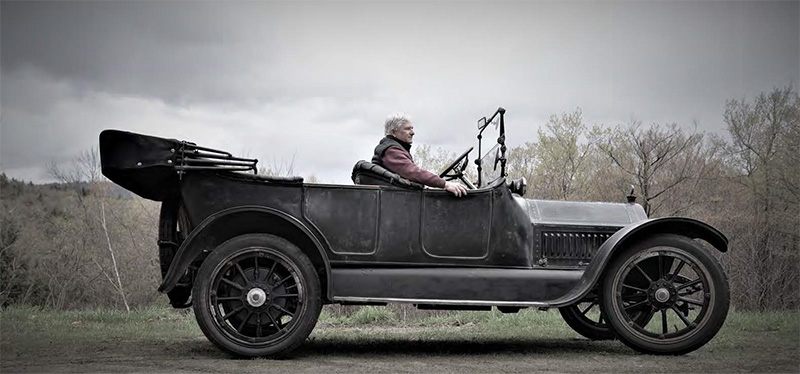
Brian Wood estimates the car had about 150,000 miles on it when he purchased it in 2004. He is the 3rd owner. He has rebuilt the engine, transmission and rear end along with the many smaller needed tweakings. He was able to confirm many of the story’s details while working on the car. He found a bent front axel, most likely the result of the drunken policeman’s wreck. There were holes in the floor where the daughter’s heels rested while driving those many mile, and the back carpet was worn through from Mr. Goetze’s feet. He always sat in the back seat on the passenger side.
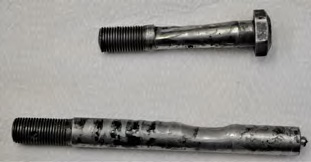
Brian has been completely through the car mechanically without changing any of its appearance, including the 109-year old leather interior. He says it was pretty much worn out. It might be hard to see these two examples of worn bolts to the right. Brian says there were many more.
The car is fantastic to be around and unbelievable when you hear the story. BUT, when you hear the engine start and the car backs out of its garage, it transports you to 1914. The sound and sight will stay with you forever if you are an old car buff.
Editor’s notes…..
A document with the above words was certified by Lina and Frieda.
Ernst Ehregott Goetze was born September 15, 1843 and died December 11, 1936.
Daughters, Lina Rose (1/26/1883-6/21/1978) and Frieda Martha (5/28/1889-12/7/1986) are buried near their dad in nearby Highland Cemetery.
Going to the Dump
It was a Friday, and someone asked me what I had planned for Saturday. My answer was….going to the dump. Wasn’t that what everyone did Saturday morning? Not anymore, I guess. But being “old school,” that’s what was on my agenda to start the day. One of my earlier memories of living in Underhill was going to the dump. We did have a burning barrel, but you also needed to go to the dump, and this was before plastic bags were popular. The first Green Up Day had paper bags to use. I still have one in the cellar. Folks with enough land usually had their own dumps. There are a few on our property. One even has a few old car parts and a rusty car body.

Going to the dump one morning shortly after we moved to Underhill, I met Ellie Cook, who was to become a good friend. She had a pickup truck with a dump body. Boy, was I envious! Our dump consisted of a bank where you threw your trash over the edge. People would go to the dump and shoot rats, popular sport back then. Every once in a while, there would be a fire and all the fire engines (trucks?) would head to the Dump Road to put the fire out. If you heard the fire whistle, if it wasn’t Tuesday at 7:00, chances are they were headed to the dump.

I think our oldest daughter’s first word was “garbage,” and when Gael’s grandmother would come to visit when she was in her 80s and 90s, she always liked to ride along with us to the dump. In the late 80s, the selectboard was looking for someone to operate the bulldozer at the new dump location. By then, the dump had moved
further up Dump Road and the garbage had to be buried. Knowing Gael could operate a bulldozer, he was asked if he could help until the town found someone permanent to do the job. He offered, and then every Saturday he would head to the dump with his truck. Like many of you, he collected stuff and brought things home that he could use. He eventually left the pickup truck home and started taking the Diamond T truck.
A few months turned into a few years and the dump began being a gathering place for the locals. Arsen Potvin, or was it Marcel LeGrand, would bring a six-pack of beer and Ed Farmer would bring lunch. Wendell Metcalf was always there too. Gael would hang the American flag from a tree when he got there. And he started a
garden where people who were getting rid of lawn ornaments and bits of outdoor things could place them. I think it was even fenced in. This is where a great deal of recycling happened. Recycling…….something people have been doing for generations!
Eventually the town dumps had to close in the early 90s, I think. The rats scattered all over town and people moved on to the newer ways of getting rid of garbage. Many people have their trash picked up at their house for a fee or go to the recycling centers. In Underhill, there is a fellow who has a location on Route 15 in Jericho called At Your Disposal. He is open on Saturday mornings from 8 – 12. He has three dumpsters: one for recycling, one for trash, and one for metal. He has a place for food scraps too. He has lived in Underhill for a long time and knows everyone. Going there is almost a social event, like the old days. I get to visit him and anyone else that happens by, and if there is a bit of gossip to hear or pass along, that’s all good too. Gerry Adams is always there with a bag of cookies made by his wife Sue to give to Nate.

So, to answer someone’s question What am I doing Saturday morning? You will find me at the dump, and I’ll check out what has been tossed into the metal dumpster. You never know what good stuff has been discarded by a neighbor. And WDEV even has a radio program Saturday morning called….”Music to Go to the Dump By.”
1926 Franklin 11A Sport Runabout Boattail
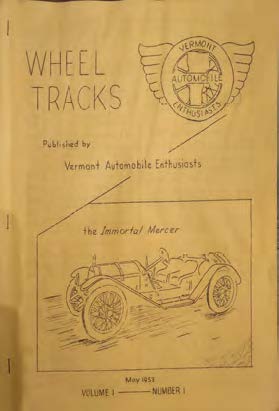
I promise that this is the last time I’ll toot my family whistle in regards to the beginnings of the VAE. After all, Gary told me, “It’s about the car.” I’ve said in past Wheel Tracks that the Franklin was the car that inspired Anne Gypson to have Ken’s car friends over for his birthday and to form a club.
Oh yeah, the car. Dad spotted the Franklin in farmer Harold Green’s field on the west side of Route 22A in Addison, Vermont. Being a Franklin and a boattail roadster to boot (Franklin’s official model designation is 11A Sport Runabout), he couldn’t not stop! It was being used, of all things, as a chicken coop. (No, not coupe.) Dad had to really twist Harold’s arm and part with $50 so Harold could build another chicken coop.
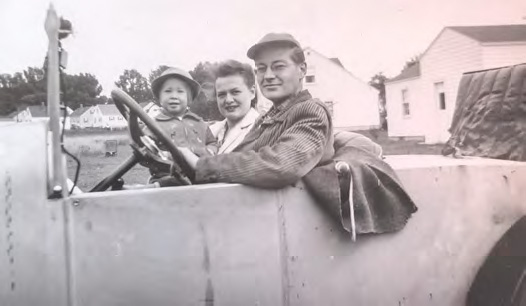
Dad was able to drive the car home to Essex Junction. I’m guessing that there are Gypson, Rice, and Galbraith stories long lost on that trip. When he got the Franklin home it just needed tires and a tune up. As I’ve written in the past, Keith Marvin drove it to New York when we moved to the Albany area. The engine was rebuilt by the last living (and legally blind) Franklin mechanic from the Troy Franklin Motor Sales Co., Inc.
Dad drove the car very little and had intentions of restoring it. Midgets and sprint cars got in the way. After dad’s passing I inherited the car. All I’ve done is put new tires on it, had the top and side curtains redone, and installed an electric fuel pump as a backup to the vacuum system. The car is insured, NYS inspected, and driven about 100 miles a year.
Editor’s note…
I hope you can see why we chose May of this year to feature the Franklin; our 70th year as the Vermont Automobile Enthusiasts! The ideas, hopes and dreams of that small group in 1953 was the beginning of this world class auto club we have today.
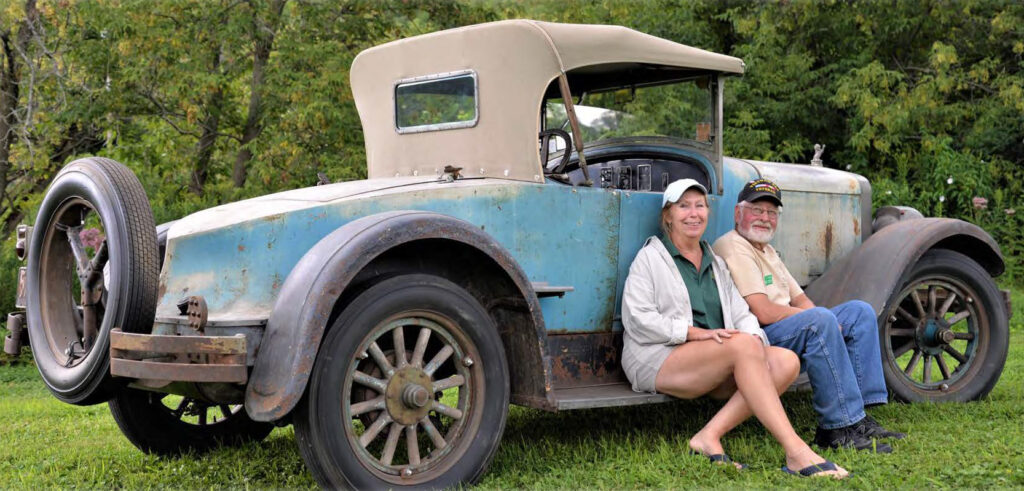
More editor notes…
The Franklin auto company was located in Syracuse, NY and built cars from 1902 until 1934. Their total production was reported at 154,022 automobiles. It is also reported that about 3700 Franklins have survived to today.
The year our featured Franklin was built, a total of 7606 automobiles were built. The models included sedans, coupes, limos, cabriolets, and roadsters. A sixth model was a sport runabout, Nancy’ and Ken’s model.
The Franklin was a high-end automobile in its day. In 1926, a Chevy or a Dodge could be purchased for around $800, A Ford model T touring car sold for $290. The least expensive Franklin, according to the Lester-Steele Handbook, was the 5-passenger touring car that sold for $2635. Some say, this is the main reason the company did not surviving the depression.
The Franklin engine was the center of the brand’s importance, you see, they were allows air cooled. The 1903 engine, when the company began, was an air cooled, 4-cylinder, that produced 10 HP. By 1905, they were using 6-cylinder engines that produced 30HP.
From 1930 to 1934 their engines were producing 100HP. Nancy and Ken’s aluminum bodied car, weighs about 2500 pounds and is powered by a 25 HP air cooled engine. Franklin’s “very light” engines were also favorites for airplanes and helicopters and were used extensively during WWll. After the war, Preston Tucker purchased the Franklin engine patent, and added a water jacket for his line of automobiles. The air cooled engine lives on today, in Poland. The Polish government purchased the engine rights in 1975 and the design is used mainly in their helicopters.
Gary Fiske
Is Now the Time in Life for Regrets?
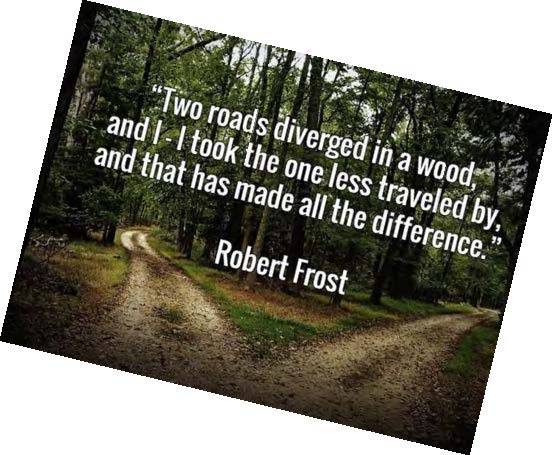
I don’t know if others about my age have moments when they think back and kind of scroll through their life and have some regrets about what they did or didn’t do, but I have. I think it was Robert Frost who wrote about coming to a fork in the road and “taking the less traveled” which got him where he was at that time. I know I took the “more traveled” as I have never been adventurous; actually, kind of a scaredy cat. As I look back, I know there have been times where I have thought I wish I had done this or that, but it is more in the realm of should have taken a pie to the new neighbor than any life-changing event.
I know I don’t regret not moving to New Jersey in the ‘60s for a housekeeping job, no matter how enticing they were making it sound. I had wanted a daughter, but when I was blessed with two (wonderful) boys, I don’t regret not trying again! I don’t regret not marrying the undertaker I had been dating, but thinking about that now, maybe it would have made more financial sense as I ease toward needing said service! No, I don’t think I have any REAL regrets. I can see what, I think, are things other people will or do regret.
I was watching the Final Four last night and the commentors were sitting at a table “commentating” when a young man came up behind them with a totally inappropriate sign for all the TV world to see. I
About 20 years ago, my son, Joshua, was just out of college and working as an assistant golf professional at a very prestigious club just outside of Boston. This job was special and unique especially for the sports minded as the owner of the Patriots football team was a member and that meant that many of the team would play golf and Josh would get to meet them. One day a man came in and asked i Drew Bledsoe (quarterback for the Patriots) was there because he wanted to get his autograph. Joshua said that “no, he wasn’t there, but the backup quarterback was,” and the man said, “Forget it. Wouldn’t want to waste my time,” and left. Do you think that today he is regretting his decision to not “waste his time”? Of course you have figured it out. He passed up getting the one and only TOM BRADY’s autograph. Guess this proves that some “regrets” can be bigger than others. Hope you don’t have any.
1914 Ford Model T
Why a Ford Model T, Fred?
Fred Gonet’s first experience driving a model T was in 2017.
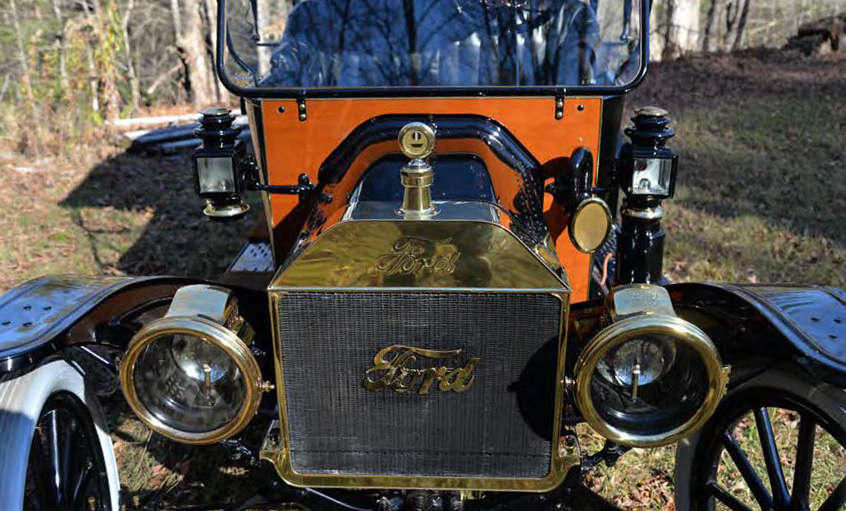
A friend in New Hampshire had asked him to come for a visit and work on some car projects he had. The friend also asked if he could tune up a couple of T’s that were to be in a 60-mile tour the next day. Unbeknownst to Fred, who had never driven a Model T, his friend’s plan was to have him drive one of them. Needless to say that Fred was “white knuckling” for a few of those first miles, especially in tight city spaces. Before the end of the tour, however, Fred had a smile on his face, and was having a hoot. He was ready for the 2nd 60-mile tour the next day.
“Model T’s are a hoot to drive.
Fred Gonet
Plus I can see now,
why everyone driving them is smiling.
They are lots of fun.”
Fred came home from New Hampshire knowing that he needed a Model T in his garage. He had driven his 1908 Locomobile for many years and hundreds of miles, but the Loco now had to make room for a T.
He remembered a friend in Massachusetts had a nice touring T, that he had seen many time since the 1980s. Larry Gould of Chelmsford had a 1914 touring and that would fit Fred fine. When asked, Larry said he had more touring plans and was not ready to sell. Larry was 99 years old at the time. Knowing that Fred was very interested, Larry’s family came to him in 2020, when Larry passed at 102 years old, and asked if he still wanted the car. The Locomobile moved over and the T came home to Proctorsville, Vermont!
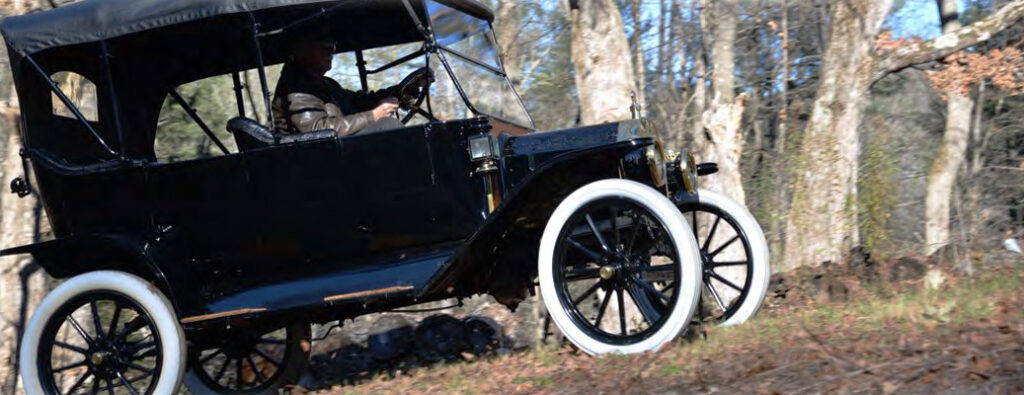
When Fred’s 1914 Model T was built, it was one of 308,162.
More Ford History…..
*In 1915, 394,788 vehicles were produced with a labor force of 18,892 employees. Over this six-year period, the production number of Model Ts per employee went from eight in 1909, to 14 in 1911, and to an astounding 20 in 1915.
*When Henry Ford introduced the moving assembly line in 1913, he loved it, but his employees didn’t. The work was boring and relentless, and worker turnover was high. He had to hire more than 52,000 workers that year to maintain his workforce of14,000.
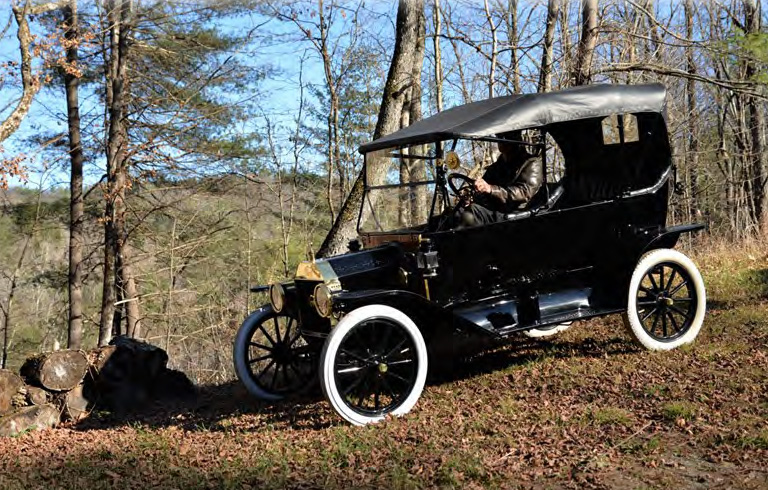
*So on January 1, 1914, Henry announced that he would double his workers’ pay from $2.34 per day to $5 per day, “as long as you were over 22 years of age and conformed to the company’s standard of clean living.” It was headline news in Detroit and around the country.
*Detroit headlines January 6, 1914….. “Ten thousand anxious, determined men, some ragged and unkempt, others seemingly prosperous, this morning fought for places in the line that stretched from the employment window at the Ford Motor Co., in Highland Park, a line that continued for many blocks from the company’s factory.”
When asked about the condition of the car when he purchased it, Fred said the it was “perfect”, but in some cases, “not correct”. Some of us have a friendly term for this type of person, but in Fred’s case that is how he has built such a successful restoration business over these many years.
“Perfect, but not Correct.”
Fred Gonet
The car’s dash was perfect, but not correct, so enter the correct dash. That has led to the steering column that was also perfect, and the coil box, and the side light brackets. Then there is that slight vibration at 40mph, since the dash is off, we might as well tear the engine and transmission apart to see if we can’t find that perfect vibration!
I am having fun with Fred here; I hope he forgives me. When I grow up, I want to be just like Fred Gonet.
From your editor, G. Fiske
Ever wondered how a beauty shop gets its name?
Have you ever wondered how a beauty shop gets its name? Well, riding shotgun in our truck as my husband, Don, drove us around Tucson this winter, the signs over the doors just sort of jumped out at me, there were so many, practically on every corner. Names like Inspirations Salon, Exotic Hair Salon, All Natural Beauty Parlor, Shear Glamour Salon. I’m not making these names up, I promise. “All Natural”? What, do they cut hair with “green” scissors? “Exotic”? Will I find male strippers in the shampoo room?

This one was one of my favorites: Maple Leaf Hair Salon, in Arizona, no less. I so wanted to yell “Stop the truck!” and get out and go in the salon just to ask the origin of the name. Is this a transplant beautician from Vermont? because I don’t think you’ll find a maple leaf anywhere here in Tucson. I’m not sure Tucsonans even know what maples trees are let alone what comes from them because Don and I seem to have stumbled on an endless supply of – horrors! — Aunt Jemima at the Sunday morning pancake breakfasts at our RV resort.

Well, as usual, I digressed from the topic at hand. So how about a salon called A Cut Above? Above what? Above 6th Street? What are they trying to imply, that they’re better than everyone else? Then there was Daisy Diamonds Hair Salon. That’s cute and intriguing, but it’s a mouthful. [Phone ringing] “Daisy Diamonds Hair Salon. How may I help you?” Maybe the joint is owned by someone named Daisy and she likes diamonds. Don saw this one: Better Beauty Parlor. Better than what? Better than All Natural Beauty Parlor?
And of course there were the salons that wanted their name front and center: Remilah’s All Beauty Salon. Bassett’s Fine Hair. This one made me think of Bassett’s Fine Furniture; wonder if they’re related.
I thought this one was cute: The Beauty Bar. Maybe I could get a cut & color and order a frozen margarita all at the same time .

Lastly, my personal favorite: Blush & Bloom. It just sounds lovely. With all the grey in my hair starting to peek through, I wonder if they have an opening for an appointment.
And this one intrigued me enough to write it down: Nueva Imagen Salon. Not knowing Spanish, I just had to get Google to translate it for me. It means New Image Salon. How about Rogue Salon? Merriam-Webster defines the noun “rogue” as a dishonest or worthless person, and the verb means to weed out inferior, diseased, or nontypical individuals. I don’t think I’d’ve chosen that name for my beauty shop.
1977 Buick Electra Limited
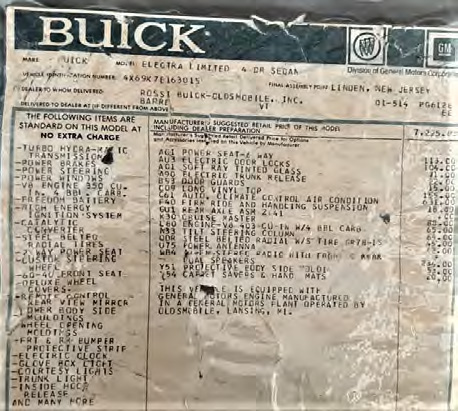
Uncle French’s 45-year-old 1977 Buick Electra Limited is now in Eric Osgood’s garage. With only 11,000 miles on the odometer, this auto has a very long life ahead.
Originally purchased by my uncle Ernest French, it was an ordered-to-spec, new purchase in 1977. It is a red-on-red car with red velour interior, and all of the whistles and bells of the day. My uncle only drove the car a few miles per year, never in the winter, and usually only on nice summer days. A couple of years ago my uncle was requiring senior living accommodations, so I purchased the Buick from him, with all of it’s 11,000 plus miles and its originality. This originality included even the original tires still on the car, however while the tread was still fine, I have replaced them due to their 45-year-old weath-er cracking. It is basically immaculate inside and out.
I have come to calling the car the “Princess” due to the pampered and pristine life it has lived, however my wife not a fan of the 70’s gawdy look refers to the car as the “Bitch”. Whether the car is known as the “P” or the “B” she has won a couple of trophies since coming into my possession. I am also trying to drive and enjoy the car a little more then my uncle did, as he told me that was the great regret that he had. RIP uncle Ernie, your car is being enjoyed!
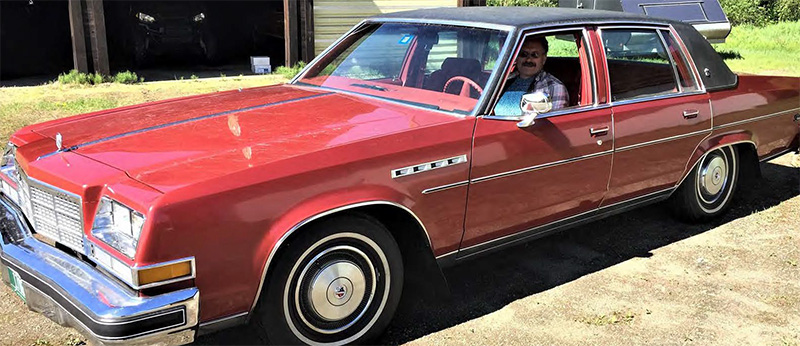
The “delivery price page” quotes $9385.85 and includes polishing and winterizing. General Motors was also pleased to publish the Buick’s gas economy as 18MPG. They add that based on the 1977 gas price of $.65 per gallon, the owner would pay $542.00 to drive 15,000 miles.
The car has a 350 CI engine with a 4 barrel carburator. The seventeen special order items includes a 6-way power seat and climate control AC. Additionally, the F40 option of “firm ride & handling suspension” and WB4, a $235 stereo radio.
GM built 51,067 Electra Limited Buicks in 1977.
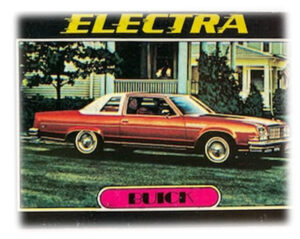
The Electra replaced the Roadmaster in 1959 and continued the line through 1991 when one Electra line became the Roadmaster Estate.
The Electra was built as a six-passenger four-door sedan like Eric’s. You could also buy it as a two-door sedan, a two-door convertible, and a five-door station wagon.
Buick has announced the Electra nameplate will return in 2024. Do you think we will be able to drive that same 15,000 miles for $542? We at Wheel Tracks did the math and today the price would be $3075. Maybe if we added few Eveready batteries, do you think?
Tap Time
I was talking to a nice (cute) young man who is doing a little logging here on the property. He was saying that he had to go to Richmond to clear a lot of blowdowns in someone’s sugarbush. I think of March as sugaring season, but some people have already made syrup, so I guess it’s all weather related. It got me thinking about when we moved here in the sixties. The farmer who lived here had a sugar-house out back, and you can still find his buckets in the woods when out walking. The old sugarhouse has collapsed, and I’m not sure if I could find it today.
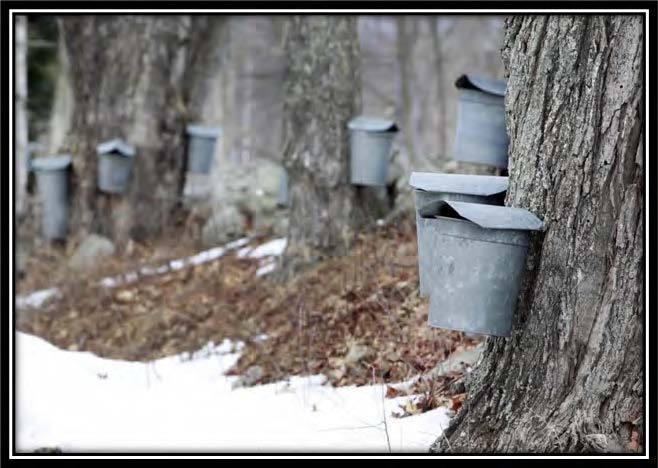
A neighbor down the road has a growing maple business and keeps increasing the number of taps by thousands every year. He taps the trees on my hill across the road and recently tapped a neighbor’s 400 acres. I got a ride through the sugar woods in the fall with his sister, and she showed me where she found the remnants of an old sugarhouse and arch deep in the woods. According to the Beers Atlas of 1859, there were a few houses on that piece of land that are no longer there.
Everyone remembers when the sap buckets would appear on trees along the road and on people’s lawns. Does anyone use buckets anymore? It’s turned into a high-tech business. Sign of the times.
When we moved here, there was a retired priest that lived a mile down the road, Father Spear. He grew up in Enosburg on a farm, and when he bought 100 acres on the English Settlement Road, he tapped a few trees near the house. We were given a pony back then that we couldn’t keep in a fenced-in area, so she wandered around the neighborhood. Fortunately, there were only a few houses on the road then, so it wasn’t much of a problem, and Father Spear always enjoyed seeing Ginger show up at his house.
Except when he had buckets on his trees. Ginger knew when he hung up the buckets and would wander down the road to his house and drink the sap out of any bucket that didn’t have a lid on it, then meander back home, walking in the middle of the road. Always when the mailman was trying to get to our house. Ginger wouldn’t budge and just kept walking in the middle of the road. I found it humorous, but Wendell, the mailman, didn’t.
We had a similar experience here when the kids hung a few buckets around the house. Our goats would drink the sap out of the kids’ buckets. The kids gave up. I wish the sugarmakers well in the upcoming season and hope Mother Nature cooperates. I look forward to the neighbors having their Open House in March.
1927 Dodge Sedan
I travel not to go anywhere, but to go. I travel for travel’s sake. The great affair is to move.
– Robert Louis Stevenson
Travel……..[trav-el] verb
To move from one place to another: seeking places to discover. A journey to a distant or unfamiliar place; a slow and steady pace can be done by train, plane, ship and especially an automobile; a one way or round trip.
To uncover cultures and open the mind; to grow and yourself find, makes you pine for places never known; makes you not want to go home.
“The Road Not Taken”
Two roads diverged in a yellow wood,
And sorry I could not travel both
And be one traveler, long I stood
And looked down one as far as I could
To where it bent in the undergrowth;
Then took the other, as just as fair,
And having perhaps the better claim
Because it was grassy and wanted wear,
Though as for that the passing there
Had worn them really about the same,
And both that morning equally lay
In leaves no step had trodden black.
Oh, I marked the first for another day!
Yet knowing how way leads on to way
I doubted if I should ever come back.
I shall be telling this with a sigh
Somewhere ages and ages hence:
Two roads diverged in a wood, and I,
I took the one less traveled by,
And that has made all the difference.
Robert Frost
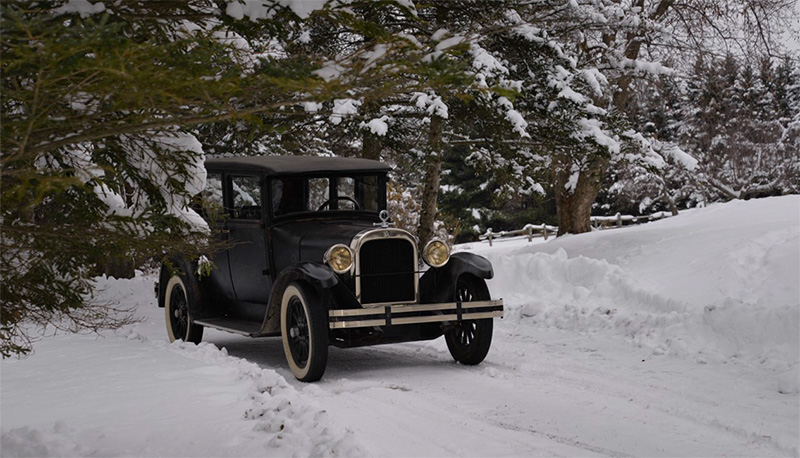
“The Old Car “
Well, the AC works fine in the win-ter,
And the heater works well in the summer.
The radiator leaks and the left wiper squeaks, but the motor is strong; she is a comer.
That the radio’s shot doesn’t matter a lot; I can sing or perhaps be a hummer. But when she breaks down and I’m ten miles from town, I just stick out my thumb…. I’m a thumber!
Cowboy Ron Williams
“Driving Through“
This could be the town you’re from,
marked only by what it’s near.
The gas station man speaks of weather
and the high school football team
just as you knew he would –
kind to strangers, happy to live here.
Tell yourself it doesn’t matter now,
you’re only driving through.
Past the sagging, empty porches
locked up tight to travelers’ stares,
toward the great dark of the fields,
your headlights startle a flock of
old love letters—still undelivered,
enroute for years.
Mark Vinz
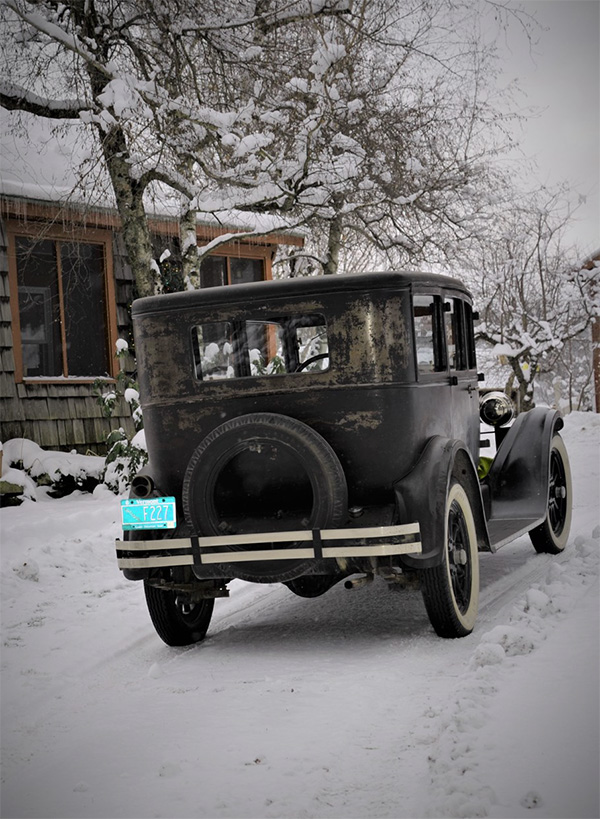
Australian bush poet, Banjo Paterso
Once she was straight
And full of pep,
Had a fast gait
And kept her step.
Now she is faded
And beginning to wrinkle,
Her eyes look jaded
And refuse to twinkle.
Her time is not long
‘Cause her lungs are weak,
Her voice once strong
Is reduced to a squeak.
My eyes they fill
When I’m tempted to part,
Because she still
Holds a place in my heart.
She carried me to hunt,
She carried me to marry,
Without a single grunt
Or suggestion of tarry.
Along the countryside
Or down by the river,
I’ve enjoyed every ride
In that dear old “flivver”.
King A. Woodburn
My old car knows, when I am near.
We have road trips in mind, to places unknown. New adventures to feel, it has been awhile.
We leave soon to a place, far away.
Her old bolts and bushings, be darn, lets go and not wait. Lets go right away.
We head out, to the north. The road moving below, the sounds are nice music to us.
I traveled this road, hundreds of times. But today with my friend, it is all brand new. Did you see that, old girl? I didn’t see it before. What’s that up ahead?
Anonymous










